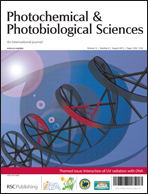In a recent experiment, the repair efficiency of DNA thymine cyclobutane dimers (T<>T) on UV excitation of 8-oxoG base paired either to C or A was reported. An electron transfer mechanism from an excited charge transfer state of 8-oxoG–C (or 8-oxoG–A) to T<>T was proposed and 8-oxoG–A was found to be 2–3 times more efficient than 8-oxoG–C in repair of T<>T. Intra base pair proton transfer (PT) in charge transfer (CT) excited states of the base pairs was proposed to quench the excited state and prevent T<>T repair. In this work, we investigate this process with TD-DFT calculations of the excited states of 8-oxoG–C and 8-oxoG–A base pairs in the Watson–Crick and Hoogsteen base pairs using long-range corrected density functional, ωB97XD/6-31G* method. Our gas phase calculations showed that CT excited state (1ππ*(CT)) of 8-oxoG–C appears at lower energy than the 8-oxoG–A. For 8-oxoG–C, TD-DFT calculations show the presence of a conical intersection (CI) between the lowest 1ππ*(PT–CT) excited state and the ground state which likely deactivates the CT excited state via a proton-coupled electron transfer (PCET) mechanism. The 1ππ*(PT–CT) excited state of 8-oxoG–A base pair lies at higher energy and its crossing with ground state is inhibited because of a high energy gap between 1ππ*(PT–CT) excited state and ground state. Thus the gas phase calculations suggest the 8-oxoG–A would have longer excited state lifetimes. When the effect of solvation is included using the PCM model, both 8-oxoG–A and 8-oxoG–C show large energy gaps between the ground state and both the excited CT and PT–CT states and suggest little difference would be found between the two base pairs in repair of the T<>T lesion. However, in the FC region the solvent effect is greatly diminished owing to the slow dielectric response time and smaller gaps would be expected.

You have access to this article
 Please wait while we load your content...
Something went wrong. Try again?
Please wait while we load your content...
Something went wrong. Try again?


 Please wait while we load your content...
Please wait while we load your content...